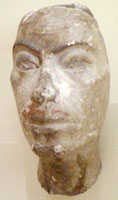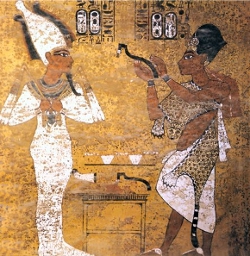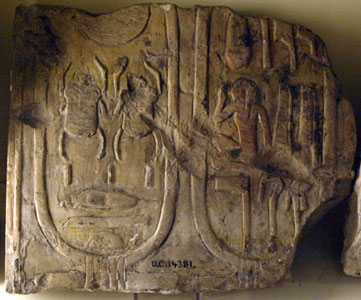
Ay (Aye) was the second last Pharaoh of the Eighteenth Dynasty of the New Kingdom of Ancient Egypt. It is thought that he ruled Egypt for four years from around 1323BC, however, he had been the vizier of both Akhenaten, Tutankhamun and possibly also of Smenkhare. It is widely believed that, in his position as the vizier of the young Tutankhamun, he was the real power behind the throne and some also suspect that he murdered Tutankhamun and married Ankhesenamun (the wife of Tutankhamun and the daughter of Akhenaten) in order to seize the throne for himself.
Family background
It seems likely that he was born in or around Akhmin (known to the Egyptians as Ipu, or Khent-min and the Greeks as Khemmis or Panopolis), the capital of the ninth nome of Upper Egypt. He constructed a chapel to Min (the patron of Akhmin) in the vicinity of the city, adding weight to this theory.
Ay is thought to have been of common birth. He may have been the son of Yuya, a respected official who held many offices including priest of Min, “Master of the Horse” (charioteer) and “Overseer of the herds of Akhmin”. If this is the case he was also the brother of Tiye (the Great Royal Wife of Amenhotep III) and may also have been of part Syrian descent. There is no conclusive evidence that Ay was Yuya’s son, but commentators have noted the physical similarities between monumental depictions of Ay and the bone structure of Yuya’s mummy. It is also possible that Ay and his wife Tiy were the parents of Nefertiti (the Great Wife of Akhenaten) and Mutnedjmet (the Great Wife of Ay’s successor Horemheb).

Ay may have had a son named Nakhtmin who may have been his intended successor. There is some evidence that Nakhtmin was granted the titles “rpat” or “irypat” (often transalted as “Crown Prince” but quite possibly only meaning “nobleman”) and “hA nhw” (King’s son), but it is generally thought more likely that he was adopted. The inscription naming Nakhmin as the King’s son is not complete, so it is sometimes suggested that Nakhmin was named as the viceroy of Nubia (King’s son of Kush) and not the heir apparent. However, there is also evidence that the Viceroy of Nubia at that time was Paser, supporting the notion that Nakhmin was the son of (or adopted son of ) Ay.
Ay is sometimes claimed to be the father of Nefertiti (the wife of Akhenaten), in part because he used the title “It Netjer” (literally “God’s Father” but in this case meaning the father-in-law of the King). However Ay’s wife Tiy is not named as the mother of Nefertiti, so it is suggested that Nefertiti was the daughter of Ay’s first (unnamed) wife and that he later married Nefertiti’s wet nurse, Tiy. This is fairly speculative and no evidence has been recovered which would support or reject this theory.
If Ay was the father of Nefertiti, he was also the father of Mutnodjemet (sometimes called Mutbenret) who may have been married to Horemheb to secure Horemheb’s position as pharaoh after Ay.
Career
Ay may have started his career in the Egyptian army (like Yuya) but soon rose to prominence in the court of the king. During Akhenaten’s reign, Ay moved with his pharaoh to Akhetaten (the city founded by Akhenaten) and was apparently a loyal subject who rejected the old gods in favour of the Aten).

Akhenaten allowed him to build a tomb near Akhetaten in which he is named as “Overseer of All the Horses of His Majesty” (the highest rank in the elite chariot division, second only to the rank of General). However, he is also given the titles “Companion”, “Head of the Companions of the King”, “Father of the God”, “Fan-bearer on the Right Side of the King” (indicating that he was a close advisor to the Pharaoh) and “Acting Scribe of the King”. There is also a copy of Akhenaten’s “Hymn to the Aten” in this tomb, although it is likely that this was required by Akhenaten and therefore this is not evidence that Ay agreed with Akhenaten’s decision to promote the Aten above all other gods.
Once Akhenaten died and Egypt was governed by Smenkhare, and then Tutankhamun, it seems that Ay engineered the return to Thebes and the restoration of the traditional gods. With the royal court back in Thebes and the young pharaoh changing his name from Tutankhaten to Tutankhamun, Ay began work on his tomb in the Valley of the Kings.

It is often suggested that Ay murdered Tutankhamun, but there is no firm evidence proving that the young king’s death was murder. Some commentators have even suggested that Ay was responsible for the deaths of Nefertiti, Smenkhare and Tutankhamun’s two infant children – but there is even less evidence to support these charges.
There is also the controversial matter of the letter written to the king of the Hittites in which an Egyptian queen (thought by many to be Ankhesenamun) requests that the Hittite king send her a son to marry so that she is not forced to marry her “subject”. The Hittite prince who was despatched to Egypt “disappeared” and may well have been another of Ay’s victims, as Ay did indeed proceed to marry Ankhesenamun.
Even if Ay did not order or cause the death of the king, he certainly profited directly from it. As a commoner, Ay’s right to rule Egypt seems to have depended entirely on his marriage to Ankhesenamun, but poor Ankhesenamun disappears from the historical record shortly after the wedding. Ankhesenamun is not mentioned in Ay’s tomb, suggesting that once he had used her to confirm his position he no longer had any use for the young queen. She may also have been a victim of his ambition.
This marriage was doubly necessary for Ay as the Commander of the Army, Horemheb, had already been named as the “idnw” (“Deputy of the Lord of the Two Lands”) of Tutankhamun and thus was the heir apparent. Yet, Ay is depicted conducting the funerary rites for Tutankhamun wearing the Blue Crown indicating that he was already named as pharaoh. It is possible that Ay and Horemheb came to an agreement regarding the succession (after all Horemheb became pharaoh on Ay’s death and Ay was already of a fairly advanced age and only ruled for four years). However, it is more likely that Ay simply outmaneuvered Horemheb by marrying Ankhesenamun almost immediate after Tutankhamun’s death and installing himself as pharaoh.
Horemheb certainly had his revenge on Ay. It was Horemheb and not Nakhtmin (possible son of Ay) who became the last pharaoh of the Eighteenth Dynasty and Horemheb may have married Ay’s daughter Mutnodjemet to consolidate his position. Once Horemheb was in charge, he began to write Akhenaten, Smenkhare, Tutankhamun, Ay and Nakhmin out of the historical record, damaging their monuments and excising their names. There is also evidence that Horemheb desecrated Ay’s tomb (KV 23 or WV23), cutting his cartouche from the inscriptions and smashing his sarcophagus into small pieces (although the lid of Ay’s sarcophagus was recovered from KV63 where it was apparently buried in rubble). Horemheb then usurped Ay’s mortuary temple at Medinet Habu replacing Ay’s name with his own. Only one example was missed, allowing us to determine that Ay was the original owner of this mortuary temple.
Name

Ay’s birth name (Aja) was generally followed by the epithet “Father of the God”. His prenomen (throne name) was Kheperkheperure Irimaat which is generally translated as “Everlasting are the Manifestations of Ra, born of Ma’at”. He also used the Horus name “Kanakht Tekhenkhau”, the Nebty name “Sekhempehtidersetet” and the Golden Horus name “Heqasekhepertawy”.
- Tutankhamun
- Was Tutankhamun murdered?
- Ankhesenpaaten (Ankhesenamun)
- Armarna Art
- Armarna Royal Family
- Armarna Religion
- The Armarna Letters
Copyright J Hill 2010